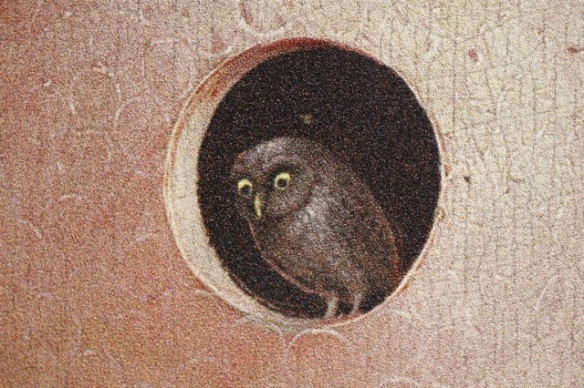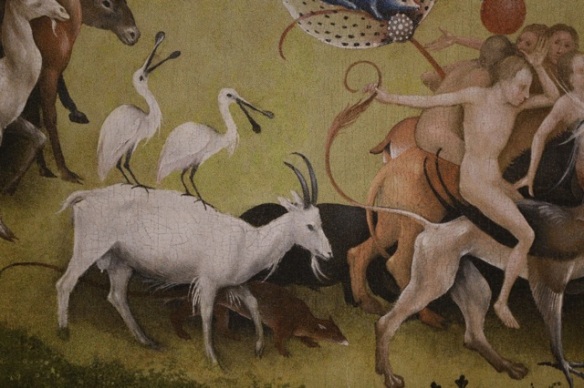This picture shows a little owl, by famous painter Hieronymus Bosch. It is in his painting The Garden of Earthly Delights.
This photo shows a little owl as well. In Bosch’s painting The Wayfarer.

That little owl, like many other animals in Bosch’s work, is a little detail in a painting full of little details.
We saw these owls on 8 July 2016, when we were in the natural history museum in Tilburg, the Netherlands.
The Tilburg exhibition on animals in Bosch’s works did not show the original works of art. These had been earlier this year in the exhibition in Den Bosch; and are now in the exhibition in the Prado museum in Madrid.
The Tilburg exhibition had reproductions of Bosch’s paintings. And also many stuffed animals of species shown by Bosch. I think there was a mistake in these stuffed animals: they included a North American black bear. A species not known to Bosch as far as I know. The bears in Bosch’s work are European brown bears; not present among the stuffed animals in the exhibition.
Why did Bosch depict so many animals? We cannot be sure. As far as we know, Bosch never wrote about his work. Many animals in Bosch’ age were used as symbols, eg of sinful or good human qualities: eg, peacocks for vanity. The catalogue of the exhibition says that many of these late medieval-early Renaissance symbolic meanings have become lost and are unclear now.
Did Bosch agree 100% with what his contemporaries thought about symbolic meanings of animals? Maybe he did not agree 100%. His works show signs of non-conformism. In west European medieval social thought, the clergy were the first estate. The nobility was the second estate. Town-dwelling bourgeois, like Bosch in Den Bosch town, were the third estate.
Tradition said that bourgeois had to mind that they did not have as many rights as clergymen, kings, counts or barons (though more than peasant serfs). However, in his The Haywain, Bosch depicted the emperor of the Holy Roman Empire and the pope as sinners who might end up in hell. He depicted a nun as a money-grabbing half pig, half human in The Garden of Earthly Delights. He depicted an armoured knight as a partly human, partly other mammal, partly bird being in hell in the same painting.
Art historian Marrigje Rikken recently wrote about images of animals between 1550 and 1630 becoming an art genre in themselves. In the dominant medieval view on art, artists worked mainly for the Roman Catholic church. They made art with religious subjects. Depicting animals could be a part of that, if it fitted in religious frameworks like the Garden of Eden or Noah’s Ark. In the sixteenth and seventeenth countries, certainly in the Low Countries, the link between artists, the Catholic church and the nobility became looser. According to Ms Rikken, there was a gradual change from earlier emblematic, symbolic depictions of animals in a religious framework to more scientific depictions; in which religion faded more and more into the background.
According to Rikken, the number of animals featured in works of art gradually increased. More and more, animals became subjects in themselves, not minor parts of religious depictions.
Was Hieronymus Bosch an early pioneer of this evolution, at least in some respects? Maybe; we don’t know for sure. He did depict many hundreds of animals. The emblematic-religious framework was still there. We may never know whether Bosch was a true believer in it. Or whether it was convenient for him as a pretext for painting or drawing animals which he loved for its own sake.
There are four types of animals in Hieronymus Bosch’s paintings. Autochthonous west European animals which Bosch knew well. Exotic animals new for west Europeans; like giraffes. And two kinds of fantasy animals. Animals which traditionally were supposed to exist, like unicorns and griffons. And animals which were products of Bosch’s own imagination; often half one animal species, half another species.
In the rest of this blog post we will confine ourselves to real animals; especially non-exotic birds; in The Garden of Earthly Delights.
Like these real spoonbills behind the bathing women.
And these two real spoonbills on the back of a real goat, walking behind fantastic animals.
And these two white storks on a pig’s back. With above them, a real barn owl sitting on an ‘unreal’ unicorn’s horn. Another proof that Bosch knew the differences between various owl species.
And finally, this hooded crow. A species which used to be common in the Netherlands in winter; but is rare there now.
There will be more on this blog about that Hieronymus Bosch exhibition. So, stay tuned!








Pingback: Real birds in Hieronymus Bosch’s fantastic paintings — Dear Kitty. Some blog Thank you, I love arts & I love animals… | spiritandanimal.wordpress.com
Reblogged this on Art, animals, and the earth.
LikeLike
Thanks for your reblog!
LikeLike
Pingback: Painter Hieronymus Bosch’s fantastic animals | Dear Kitty. Some blog
Pingback: Butterfly and flowers | Dear Kitty. Some blog
Pingback: Little owl sees cat, video | Dear Kitty. Some blog
Pingback: Painter Leonardo da Vinci, new film, review | Dear Kitty. Some blog
Pingback: Painter Hieronymus Bosch, new film | Dear Kitty. Some blog
Pingback: New Hieronymus Bosch film, review | Dear Kitty. Some blog
Pingback: Barnowl couple video | Dear Kitty. Some blog
Pingback: Dutch Aert Schouman’s eighteenth century bird painting exhibited | Dear Kitty. Some blog
Pingback: Hieronymus Bosch, still inspiring art | Dear Kitty. Some blog
Pingback: Dutch birds and bats, good news | Dear Kitty. Some blog
Pingback: Jackdaws eat invasive caterpillars, video | Dear Kitty. Some blog
Pingback: Lakenhal museum, Lucas van Leyden, Rembrandt, Wolkers | Dear Kitty. Some blog
Pingback: Roman poet Ovid, owls, superstition and love | Dear Kitty. Some blog